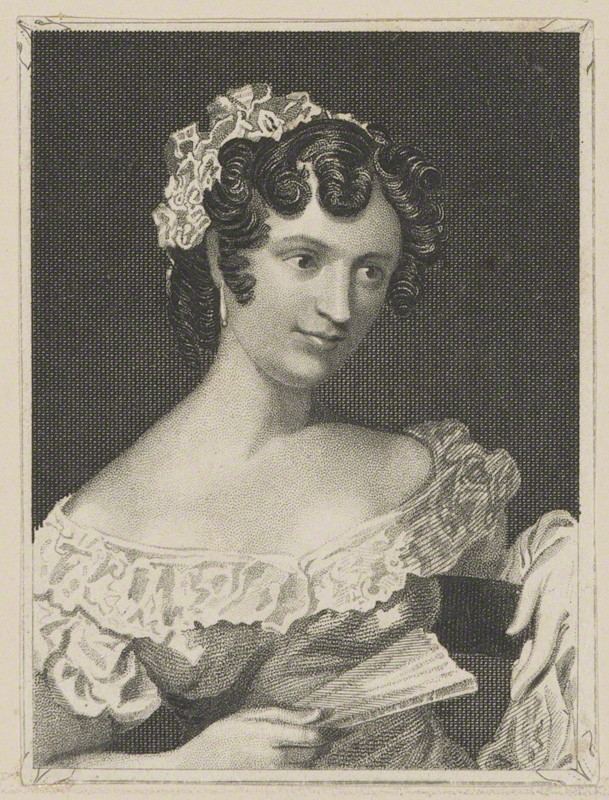Name Harriet Waylett | ||
 | ||
Harriet Waylett (1798–1851) was an English actress and theatre manager.
Contents
Early life
The daughter of a tradesman in Bath, Somerset, Harriet Cooke was born there on 7 February 1798; her uncle was a member of the Drury Lane Theatre company, and Sarah Cooke was her cousin. After receiving some instruction in music from one of the Loders of Bath, she appeared on the Bath stage on 16 March 1816 as Elvina in W. R. Hewetson's Blind Boy. She then acted at Coventry, where she met and married in 1819 Waylett, an actor in the company. In 1820 she was at the Adelphi Theatre, where she was the original Amy Robsart in James Planché's adaptation of Kenilworth, and the first Sue to her husband's Primefit in William Moncrieff's Tom and Jerry. She played as "Mrs. Waylett late Miss Cooke of Bath".
In 1823 Mrs. Waylett was acting in Birmingham under Alfred Bunn, playing in Sally Booth's part of Rose Briarly in Husbands and Wives. Her singing of Rest thee, Babe, in Guy Mannering established her in favour.
The London stage
Mrs. Waylett accompanied her manager Bunn to Drury Lane Theatre, with a reputation as for chambermaid part and as singer. She appeared as Madge in Love in a Village on 4 December 1824. On 14 January 1825 Mrs. Waylett was Mrs. Page in The Merry Wives of Windsor. She had incurred the jealousy of Bunn's wife, and shortly moved on.
On 12 May Mrs. Waylett made, as Zephyrina in the Lady and the Devil, her first appearance at the Haymarket Theatre. She stood in high favour as a singer and actress also in Dublin and Cork.
After her return from Dublin, Mrs. Waylett played at the Haymarket, Drury Lane, Queen's Theatre, the Olympic Theatre, Covent Garden, and other houses. In 1832 she was acting at the Strand Theatre, where in 1834 she was sole manager. Here she also played original parts. The performances were nominally gratis: admission to the house was in fact by paying four shillings an ounce at a neighbouring shop for sweetmeats, or purchasing tickets for the Victoria Theatre. There were few London houses at which she was not seen, and she was a favourite in the country. In October 1835 she received in Dublin £800 and half a clear benefit for twenty-one nights' performances. In 1838 she was engaged again at the Haymarket.
Last years
In May 1843 Mrs. Waylett, as she was still called after her second marriage, was at the Lyceum Theatre, where she was the President in The Ladies' Club, and played in the farce of Matrimony. Through ill-health her appearances became infrequent, and in 1849 she was spoken of as retired. She died on 29 April 1851, after a long and painful illness. She was thought one of the best soubrettes of her day.
Family and scandal
Mrs. Waylett's life was associated with many scandals. Before her marriage accompanied to London a Captain Dobyn, against whom her father brought an action for loss of service. It was tried at Taunton and compromised.
Fulsome praise of Mrs. Waylett in the Theatrical Looker-On, a Birmingham paper associated in the mind of the Birmingham public with Alfred Bunn, gave rise to a crop of scandals. There were legal threats on Bunn's part, of prosecutions for libel. Bunn demanded an apology for what was said concerning the two as a couple in William Oxberry's Dramatic Biography in 1827. Oxberry refused to apologise, and there was talk of a duel. Mrs. Waylett was taxed with ostentatiously overdressing the chambermaid parts in which she was seen.
Harriet had married the actor Waylett in 1819; he was a bigamist under the name Fitzwaylett, and died in 1840. They had been long been separated. She shortly afterwards married George Alexander Lee, who survived her a few months, dying on 8 October 1851, at the end of his days playing the piano for poses plastiques.
